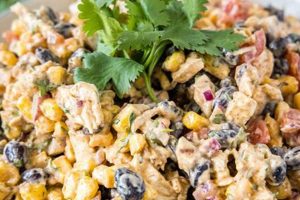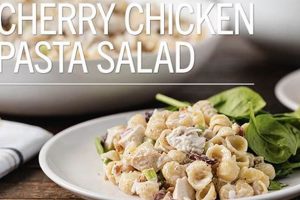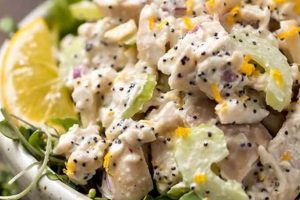A combination of cooked chicken, typically shredded or diced, bound with a creamy dressing, and enhanced with the sweetness of grapes and the satisfying crunch of almonds constitutes a classic dish. Variations may include different types of grapes (green, red, or a mixture), almond forms (slivered, sliced, or whole), and additional ingredients like celery, onion, or herbs. Mayonnaise-based dressings are common, but alternatives like Greek yogurt or avocado-based dressings offer lighter options.
This dish offers a balance of protein, healthy fats, and natural sweetness. Its adaptable nature makes it appropriate for a variety of occasions, from casual lunches to more formal gatherings. It can be served as a sandwich filling, a salad topping, or enjoyed on its own. The historical origins of chicken salad are unclear, but its rise in popularity coincided with the increasing availability of commercially produced mayonnaise in the late 19th and early 20th centuries. The inclusion of grapes and almonds adds textural and flavor complexity, elevating the dish beyond basic chicken salad.
Further exploration might include variations on the basic formula, nutritional information, tips for preparation and storage, and suggestions for serving. Different cultural interpretations and regional preferences can also be examined.
Tips for Preparing Chicken Salad with Grapes and Almonds
Optimizing the preparation of this dish involves attention to detail and ingredient selection. The following tips offer guidance for achieving a superior result.
Tip 1: Chicken Selection and Preparation: Using high-quality, properly cooked chicken is paramount. Roasting or poaching chicken breasts yields optimal flavor and texture. Avoid using pre-cooked or processed chicken, as these can compromise the final product.
Tip 2: Grape Selection: Seedless grapes, whether green, red, or a combination, are recommended for ease of consumption. Ensure grapes are fresh and firm.
Tip 3: Almond Preparation: Toasting almonds briefly enhances their flavor and adds a desirable crunch. Slivered or sliced almonds are generally preferred for their size and texture.
Tip 4: Dressing Considerations: While mayonnaise is traditional, Greek yogurt or avocado-based dressings offer lighter, healthier alternatives. Adjusting the amount of dressing allows for customization of creaminess.
Tip 5: Enhancing Flavor: Incorporating finely diced celery or red onion adds complexity and depth. Fresh herbs, such as dill or chives, provide a subtle aromatic lift.
Tip 6: Balancing Sweetness and Acidity: A touch of lemon juice or apple cider vinegar can balance the sweetness of the grapes and enhance the overall flavor profile.
Tip 7: Chilling and Serving: Chilling the prepared salad for at least 30 minutes allows the flavors to meld. Serve chilled as a sandwich filling, on crackers, or as a stand-alone salad.
Attention to these details ensures a flavorful and texturally satisfying result. The combination of high-quality ingredients and thoughtful preparation elevates this dish from simple to exceptional.
By following these guidelines, one can achieve a consistently delicious and satisfying culinary experience.
1. High-quality Chicken
High-quality chicken plays a crucial role in the overall success of chicken salad with grapes and almonds. The chicken provides the foundational flavor and texture, significantly impacting the final dish’s quality. Tender, flavorful chicken enhances the other ingredients, while dry, bland chicken can detract from the overall experience. Consider the difference between using freshly roasted chicken breast versus pre-cooked, processed chicken. The roasted chicken offers a depth of flavor and moistness that elevates the salad, while the pre-cooked option often results in a drier, less flavorful outcome. This distinction underscores the importance of prioritizing chicken quality.
The impact extends beyond taste and texture. High-quality chicken generally indicates better sourcing and handling practices, potentially contributing to food safety and nutritional value. Choosing chicken from reputable sources, such as butchers or higher-end grocery stores, often translates to a superior product. For instance, free-range or organic chicken typically possesses a richer flavor profile compared to conventionally raised chicken. This enhanced flavor directly translates to a more satisfying chicken salad experience. Selecting chicken with minimal added sodium or preservatives also contributes to a healthier and more flavorful dish.
In conclusion, prioritizing high-quality chicken represents a fundamental step in creating exceptional chicken salad with grapes and almonds. The chicken’s quality directly influences the dish’s flavor, texture, and overall enjoyment. Investing in superior chicken enhances the culinary experience and contributes to a healthier, more satisfying meal. Understanding this connection allows for informed choices that elevate the final product from simple to exceptional.
2. Fresh Grapes
Fresh grapes contribute a critical element of sweetness and texture to chicken salad, differentiating it from other savory salads. Grape selection and preparation significantly influence the final dish’s overall quality and balance. Understanding the nuances of grape incorporation allows for a more informed approach to recipe development and execution.
- Variety Selection
Different grape varieties offer varying levels of sweetness and tartness. Green grapes, such as Thompson Seedless, provide a crisp, clean sweetness, while red grapes, like Red Globe or Crimson Seedless, offer a slightly sweeter, sometimes more complex flavor profile. The choice of grape variety influences the overall flavor balance of the salad. For instance, using a mix of green and red grapes can introduce a more nuanced sweetness and visual appeal. Careful consideration of grape variety ensures the desired flavor profile is achieved.
- Freshness and Quality
The freshness of grapes directly impacts the chicken salad’s quality. Plump, firm grapes with intact skins indicate optimal freshness. Avoid grapes that appear wrinkled, soft, or have blemishes. Fresh grapes contribute a juicy burst of flavor and maintain their texture within the salad. Using less-than-fresh grapes can result in a mushy texture and a less vibrant flavor, detracting from the overall enjoyment of the dish.
- Preparation and Incorporation
Proper preparation enhances the grape’s contribution to the salad. Washing and thoroughly drying the grapes before incorporating them prevents excess moisture from diluting the dressing. Halving or quartering larger grapes ensures even distribution and prevents large bites of grape from overwhelming the other ingredients. This attention to detail contributes to a more balanced and enjoyable textural experience.
- Balancing Flavors
The sweetness of grapes interacts with the other ingredients in the chicken salad, necessitating careful balancing of flavors. The creamy dressing, savory chicken, and crunchy almonds each contribute to the overall taste profile. Adjusting the quantity of grapes or incorporating a touch of acidity, such as lemon juice, can fine-tune the balance and prevent excessive sweetness. This ensures a harmonious blend of flavors.
The careful selection, preparation, and incorporation of fresh grapes elevates chicken salad with grapes and almonds beyond a simple combination of ingredients. The grapes contribute not only sweetness and texture but also visual appeal, creating a more complex and satisfying culinary experience. Understanding these nuances allows for a more deliberate and successful approach to creating a truly exceptional dish.
3. Crunchy Almonds
Textural contrast plays a vital role in culinary enjoyment. Within a chicken salad featuring grapes and almonds, the almonds contribute a crucial element of crunch, counterbalancing the softer textures of the chicken and grapes. This textural interplay elevates the dish beyond a simple combination of ingredients, creating a more dynamic and engaging sensory experience. Consider the difference between a salad with predominantly soft textures and one that incorporates a crunchy element. The introduction of crunch adds a layer of complexity, stimulating the palate and enhancing overall enjoyment. This principle applies directly to the role of almonds in chicken salad.
The specific form of almonds utilized influences the intensity and character of the crunch. Slivered almonds offer a delicate, subtle crispness, while coarsely chopped or whole almonds provide a more robust, pronounced crunch. The choice depends on individual preference and the desired overall texture of the salad. For instance, a salad emphasizing delicate flavors and textures might benefit from slivered almonds, whereas a more robust salad could accommodate coarser almond pieces. Furthermore, toasting the almonds enhances their inherent nuttiness and intensifies their crunch. This additional step elevates the flavor profile and textural contribution of the almonds, further enriching the salad.
The crunch of almonds contributes not only to textural complexity but also to the overall perception of freshness and quality. A crisp almond suggests freshness and proper storage, while a soft or stale almond can detract from the overall sensory experience. Maintaining almond freshness is therefore crucial for maximizing their contribution to the dish. Proper storage in an airtight container, away from heat and moisture, preserves their desirable crunch. In conclusion, the crunch of almonds represents a significant component of a successful chicken salad with grapes and almonds. This textural element elevates the dish, creating a more dynamic and enjoyable culinary experience. Careful consideration of almond form and freshness ensures optimal textural contrast and flavor enhancement.
4. Balanced Dressing
Dressing constitutes a critical component in chicken salad with grapes and almonds, binding the ingredients and contributing significantly to the overall flavor profile. A balanced dressing complements the other components without overpowering them, creating a harmonious blend of flavors and textures. Achieving this balance requires careful consideration of the dressing’s ingredients, consistency, and overall flavor profile in relation to the chicken, grapes, and almonds.
- Flavor Profile
The dressing’s flavor profile should complement the existing flavors of the chicken, grapes, and almonds. Traditional mayonnaise-based dressings offer a creamy, tangy backdrop that harmonizes with the sweetness of the grapes and the nuttiness of the almonds. However, variations incorporating Greek yogurt, sour cream, or avocado can introduce additional nuances, such as tanginess or richness. The key is to select a flavor profile that enhances the overall composition without dominating it. For example, a Dijon mustard-based dressing adds a sharp counterpoint to the sweetness, while a honey-mustard dressing contributes a touch of sweetness and complexity. The selected flavor profile significantly influences the final character of the dish.
- Consistency and Texture
Dressing consistency directly impacts the salad’s texture and mouthfeel. A thick, creamy dressing clings to the ingredients, creating a cohesive and rich experience. A thinner dressing, on the other hand, offers a lighter, more delicate texture. The desired consistency depends on personal preference and the overall composition of the salad. A thicker dressing might be preferred for a more traditional, substantial salad, while a thinner dressing could complement a lighter, more refreshing variation. Furthermore, the dressing’s texture interacts with the textures of the other ingredients. A creamy dressing contrasts with the crunch of almonds and the juiciness of grapes, creating a multi-dimensional textural experience.
- Acidity and Sweetness
Balancing acidity and sweetness within the dressing is crucial for achieving a harmonious flavor profile. The sweetness of the grapes often necessitates a counterbalancing acidity in the dressing. This acidity can be achieved through the incorporation of lemon juice, vinegar, or other acidic ingredients. The balance between sweetness and acidity prevents the salad from becoming overly sweet or cloying. For example, a dressing containing a touch of apple cider vinegar balances the sweetness of the grapes, creating a more complex and refreshing flavor profile. This balance ensures the overall flavor profile remains balanced and engaging.
- Ingredient Ratios
The ratio of ingredients within the dressing significantly impacts its overall flavor and consistency. Careful measurement and adjustment of ingredients, such as mayonnaise, yogurt, or spices, are essential for achieving the desired balance. Too much of one ingredient can overwhelm the others, disrupting the harmony of flavors. For example, an excessive amount of mayonnaise can result in a heavy, overly rich dressing, while too much lemon juice can make it excessively tart. Precise ingredient ratios ensure the dressing complements the other components without overpowering them.
A balanced dressing elevates chicken salad with grapes and almonds, transforming it from a simple combination of ingredients into a cohesive and flavorful dish. Careful consideration of the dressing’s flavor profile, consistency, acidity, and ingredient ratios ensures a harmonious blend of flavors and textures. This attention to detail ultimately enhances the overall culinary experience, creating a more satisfying and enjoyable meal. Achieving this balance allows the individual flavors of the chicken, grapes, and almonds to shine while simultaneously creating a unified and delicious whole.
5. Proper Chilling
Proper chilling plays a crucial role in the final quality and safety of chicken salad with grapes and almonds. Chilling allows the flavors of the various componentschicken, grapes, almonds, and dressingto meld and mature, resulting in a more cohesive and nuanced flavor profile. This flavor development occurs as the ingredients interact within the chilled environment, allowing their individual flavors to harmonize. Furthermore, chilling enhances the textural integrity of the salad. It firms the chicken and grapes, maintaining their desirable textures and preventing them from becoming mushy. This effect is particularly noticeable with the grapes, which can become soft and less appealing if not adequately chilled. For example, a freshly made chicken salad might taste disjointed, with the individual flavors of the chicken, grapes, and almonds remaining distinct. After proper chilling, however, these flavors blend, creating a more unified and complex taste experience. The difference is often perceptible, highlighting the importance of this often-overlooked step.
Beyond flavor and texture enhancement, proper chilling is essential for food safety. Chicken salad, containing mayonnaise and other perishable ingredients, provides an ideal environment for bacterial growth if left at room temperature for extended periods. Chilling inhibits bacterial proliferation, significantly reducing the risk of foodborne illness. Adhering to safe food handling practices, including prompt and adequate chilling, is crucial for minimizing health risks associated with consuming perishable foods like chicken salad. For instance, leaving chicken salad at room temperature for more than two hours can lead to a dangerous increase in bacterial populations, potentially causing illness if consumed. Therefore, proper chilling is not merely a culinary enhancement but a critical food safety measure.
In summary, proper chilling is integral to the success of chicken salad with grapes and almonds. It enhances flavor development, preserves desirable textures, and ensures food safety. Understanding the impact of chilling and implementing appropriate chilling practices elevates the culinary experience and safeguards against potential health risks. This seemingly simple step contributes significantly to both the enjoyment and safety of this popular dish.
Frequently Asked Questions
This section addresses common inquiries regarding the preparation and enjoyment of chicken salad incorporating grapes and almonds. Clarity on these points contributes to a more informed and successful culinary experience.
Question 1: What type of chicken is best suited for this recipe?
While various chicken types can be utilized, roasted or poached chicken breast offers optimal flavor and texture. These methods preserve moisture and enhance the chicken’s inherent flavor, contributing positively to the overall quality of the salad.
Question 2: Can other nuts be substituted for almonds?
Substitutions are possible, though they may alter the flavor profile. Walnuts, pecans, or cashews offer potential alternatives, each imparting its unique flavor and texture. Consider the interplay of flavors between the chosen nut and the other ingredients when making a substitution.
Question 3: How can one achieve a lighter, healthier version of this dish?
Substituting Greek yogurt or avocado for a portion of the mayonnaise creates a lighter dressing with a tangy or creamy element, respectively. Reducing the overall amount of dressing also contributes to a lighter result.
Question 4: How long can this chicken salad be stored safely?
Properly stored in an airtight container within refrigeration, chicken salad typically remains safe for consumption for up to three to five days. Always prioritize safe food handling practices and discard any salad exhibiting signs of spoilage.
Question 5: Can this salad be prepared in advance for an event?
Advance preparation is possible. Prepare the salad up to 24 hours prior to serving, storing it tightly covered in refrigeration. This allows flavors to meld, enhancing the final product.
Question 6: How can one adjust the recipe to accommodate dietary restrictions, such as gluten intolerance?
Ensuring gluten-free preparation involves careful selection of ingredients. Utilize gluten-free bread or crackers when serving, and verify all incorporated ingredients, including dressings and seasonings, are certified gluten-free.
Understanding these aspects contributes to a more informed and successful approach to preparing and enjoying chicken salad featuring grapes and almonds. Careful consideration of ingredients, techniques, and storage practices ensures a safe and satisfying culinary experience.
Further exploration might include variations on the basic recipe, detailed nutritional information, or specific serving suggestions for various occasions.
Chicken Salad with Grapes and Almonds
Exploration of this dish reveals a compelling interplay of flavors and textures. High-quality chicken forms the foundation, providing essential protein and savory notes. Fresh grapes contribute sweetness and a refreshing counterpoint, while the inclusion of almonds introduces a satisfying textural complexity. A balanced dressing, whether classic or innovative, harmonizes these elements, creating a cohesive culinary experience. Proper chilling allows flavors to meld, further enhancing the final product. Ingredient selection, preparation techniques, and attention to detail contribute significantly to the dish’s overall success. From the selection of plump, fresh grapes to the subtle crunch of toasted almonds, each component plays a vital role.
Chicken salad with grapes and almonds represents more than a simple combination of ingredients; it embodies a thoughtful approach to culinary creation. Understanding the nuances of each component and their interaction allows for a more informed and rewarding experience. This exploration encourages culinary experimentation and appreciation for the delicate balance achieved through careful ingredient selection and preparation. This classic dish offers continued potential for creative adaptation and personalized interpretation, ensuring its enduring appeal within the culinary landscape.






